Arcadia 2001
 | |
 Emerson Arcadia 2001 video game console | |
| Manufacturer | Emerson Radio |
|---|---|
| Type | Home video game console |
| Generation | Second generation |
| Release date | May 1982[1] |
| Lifespan | 18 months |
| Discontinued | 1984 |
| Media | ROM cartridge |
| CPU | Signetics 2650 |
| Memory | 1 KB RAM |
| Graphics | 128 × 208 / 128 × 104, 8 Colours |
| Controller input | 2 x Intellivision-style controller (12 button keypad and 'fire' buttons on the sides) |
| Power | 12-volt |
Arcadia 2001 is a second-generation 8-bit home video game console released by Emerson Radio in May 1982, several months before the release of ColecoVision. It was discontinued only 18 months later, with a total of 35 games having been released.[2] Emerson licensed the Arcadia 2001 to Bandai, which released it in Japan.[2] Over 30 Arcadia 2001 clones exist.
The unrelated Arcadia Corporation, manufacturer of the Atari 2600 Supercharger add-on, was sued by Emerson for trademark infringement. Arcadia Corporation then changed its name to Starpath.[3]
Description[edit]
The Arcadia is much smaller than its contemporary competitors and is powered by a standard 12-volt power supply so it can be used in a boat or a vehicle. It also has two outputs (or inputs) headphone jacks on the back of the unit, on the far left and far right sides.
The system came with two Intellivision-style controllers with a 12-button keypad and 'fire' buttons on the sides. The direction pads have a removable joystick attachment. Most games came with BoPET overlays that could be applied to the controller's keypads. The console itself had five buttons: power, start, reset, option, and select.
There are at least three different types of cartridge case styles[4] and artwork, with variations on each. Emerson-family cartridges come in two different lengths (short and long) of black plastic cases.
Technical specifications[edit]
- Main Processor: Signetics 2650 CPU (some variants run a Signetics 2650A)
- RAM: 1 KB
- ROM: None
- Video display: 128 × 208 / 128 × 104, 8 Colours
- Video display controller: Signetics 2637 UVI @ 3.58 MHz (NTSC), 3.55 MHz (PAL)
- Sound: Single Channel "Beeper" + Single Channel "Noise"
- Hardware Sprites: 4 independent, single color
- Controllers: 2 × 2 way
- Keypads: 2 × 12 button (more buttons on some variants)
Console variants and clones[edit]
| Name | Manufacturer | Country | Compatibility family | Image |
|---|---|---|---|---|
| Advision Home Arcade | Advision | Emerson console | ||
| Arcadia | Bandai | Emerson console | ||
| Arcadia 2001 | Emerson | Emerson console | 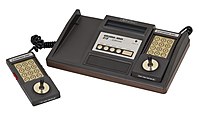 | |
| Cosmos | Tele-Computer | Emerson console | ||
| Dynavision | Morning-Sun Commerce | MPT-03 console | ||
| Educat | Unknown | MPT-03 console | ||
| Ekusera | P.I.C. | MPT-03 console | ||
| Hanimex MPT-03 | Hanimex | MPT-03 console | ||
| HMG-2650 | Hanimex | Emerson console | 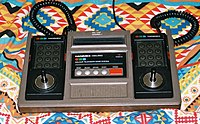 | |
| Home Arcade Centre | Hanimex | Emerson console | ||
| Intelligent Game MPT-03 | Intelligent Game | MPT-03 console | ||
| Intercord XL 2000 System | Intercord | Emerson console | ||
| Intervision 2001 | Intervision | Ormatu console |  | |
| ITMC MPT-03 | ITMC | MPT-03 console | ||
| Leisure-Vision | Leisure-Dynamics | Emerson console | ||
| Leonardo | GiG Electronics | Emerson console | ||
| Home Entertainment Centre Ch-50 | Inno-Hit | ? | ||
| Ormatu 2001 | Ormatu Electronics BV | Ormatu console | ||
| Palladium Video-Computer-Game | Neckermann | Palladium console | ||
| Polybrain Video Computer Game | Polybrain | Palladium console | ||
| Poppy MPT-03 Tele Computer Spiel | Poppy | MPT-03 console | ||
| Prestige Video Computer Game MPT-03 | Prestige | MPT-03 console | ||
| Robdajet MPT-03 | MPT-03 console | |||
| Rowtron 2000 | Rowtron | MPT-03 console | ||
| Schmid TVG-2000 | Schmid | Emerson console | ||
| Sheen Home Video Centre 2001 | Sheen | Ormatu console | ||
| Soundic MPT-03 | Soundic | MPT-03 console | 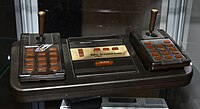 | |
| Mr. Altus, Tele Gehirn(tele brain) | HGS Electronic | Palladium console | 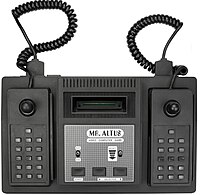 | |
| Tele-Fever | Tchibo | Emerson console | 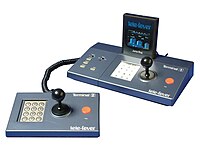 | |
| Tempest MPT-03 | Tempest | MPT-03 console | ||
| Tobby MPT-03 | Tobby | ? | MPT-03 console | |
| Trakton Computer Video Game | Trakton | Palladium console | ||
| Tryom Video Game Center | Tryom | MPT-03 console | ||
| Tunix Home Arcade | Monaco Leisure | Emerson console | ||
| UVI Compu-Game | Orbit Electronics | Orbit console | ||
| Video Master | Grandstand | Orbit console |
Bandai Arcadia[edit]
 | |
| Manufacturer | Bandai |
|---|---|
| Type | Video game console |
| Generation | Second generation |
| Media | ROM cartridge |
| CPU | Signetics 2650 @ 3.58 MHz |
| Predecessor | Bandai Super Vision 8000 |
| Successor | Bandai RX-78 |
In 1982, the Bandai Arcadia, a variant of the Emerson Arcadia 2001, was released in Japan by Bandai. There were four Japan-exclusive game releases developed by Bandai which were the only known Arcadia titles written by other companies than UA Ltd.
- Doraemon
- Dr. Slump
- Mobile Soldier Gundam
- Super Dimension Fortress Macross
Reception[edit]
After seeing the Arcadia 2001 at the summer 1982 Consumer Electronics Show, Danny Goodman of Creative Computing Video & Arcade Games reported that its graphics were similar to the Atari 2600's, and that "our overall impression of the game play was favorable for a system in this price range, though no cartridge stands out as being an exciting original creation". He called the controller offering both Intellivision-like disc and joystick functionality "A great idea".[5]
Games[edit]
Emerson planned to launch the console with 19 games.[5] Some Arcadia 2001 games are ports of lesser-known arcade games such as Route 16, Jungler, and Jump Bug, which were not available on other home systems.
Emerson actually created many popular arcade titles including Pac-Man, Galaxian and Defender for the Arcadia, but never had them manufactured as Atari started to sue its competitor companies for releasing games to which it had exclusive-rights agreements.[6] Early marketing showed popular arcade games, but they were later released as clones. For instance, the Arcadia 2001 game Space Raiders is a clone of Defender, and Breakaway is a clone of Breakout.[7]
- 3D Attack - a Zaxxon clone[8]
- 3-D Bowling - a Bowling game released for the Arcadia by Emerson Radio Corp. in 1982.
- 3-D Raceway - 3D Raceway
- 3-D Soccer - a Soccer game released by Emerson Radio Corp. for the Arcadia in 1982.
- Alien Invaders - is a Shoot-'Em-Up game released by Emerson Radio Corp. for the Arcadia in 1982.
- Astro Invader
- American Football - is a Football game released by Emerson Radio Corp. for the Arcadia in 1982.
- Baseball
- Brain Quiz
- Breakaway
- Capture
- Cat Trax
- Crazy Gobbler
- Crazy Climber (unreleased)
- Escape
- Funky Fish
- Galaxian
- Grand Prix 3-D
- Grand Slam Tennis
- Hobo
- Home Squadron
- Horse Racing (plays similar to the Intellivision version)
- Jump Bug
- Jungler
- Kidou Senshi Gundamu (only in Japan)
- Math Logic
- Missile War
- Ocean Battle
- Pleiades
- RD2 Tank
- Red Clash
- Robot Killer (clone of Berzerk)
- Route 16
- Soccer
- Space Attack
- Space Chess
- Space Mission
- Space Raiders
- Space Squadron
- Space Vultures
- Spiders
- Star Chess
- Super Bug
- Super Gobbler
- Tanks A Lot
- The End
- Turtles/Turpin
References[edit]
- ^ Forster, Winnie (2005). The encyclopedia of consoles, handhelds & home computers 1972 - 2005. GAMEPLAN. p. 57. ISBN 3-00-015359-4.
- ^ a b Watcher, Dark. "Emerson Arcadia 2001 - DW Facts". Video Game Console Library. Retrieved 6 January 2014.
- ^ The Dot Eaters - Epyx | The Dot Eaters
- ^ obsoletemedia.org: Emerson Arcadia 2001 (1982 – 1984)
- ^ a b Goodman, Danny (Spring 1983). "Home Video Games: Video Games Update". Creative Computing Video & Arcade Games. p. 32.
- ^ "Arcadia 2001: Frequently Asked Questions". digitpress.com. 2002-06-04. Retrieved 2017-03-01.
- ^ Lester, John. "History of Consoles: Arcadia 2001 (1982)". Gamster81. Retrieved 6 January 2014.
- ^ "Arcadia 2001 Gaming Guide".
External links[edit]
| Wikimedia Commons has media related to Arcadia 2001 and clones. |
- Video Game Console Library entry on the Arcadia 2001
- TheGameConsole.com entry on the Arcadia 2001
- The Dot Eaters entry on the Arcadia 2001
- www.old-computers.com Emerson Arcadia 2001 museum entry
- www.old-computers.com Article about Arcadia 2001 and clones
- Arcadia 2001 retrospective at IGN

No comments:
Post a Comment